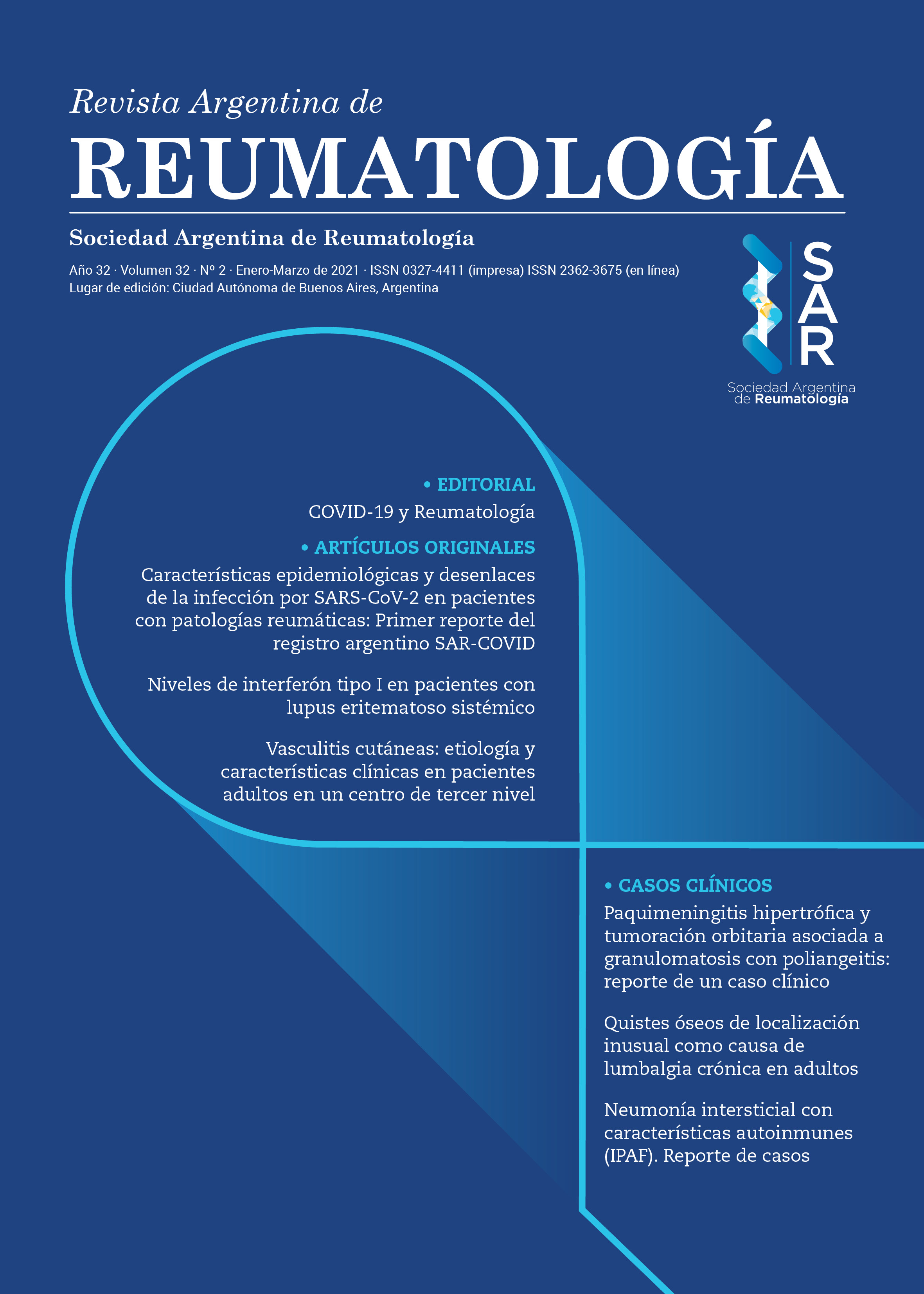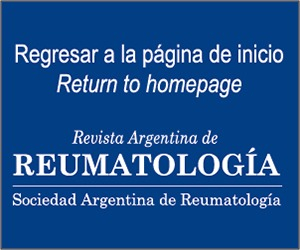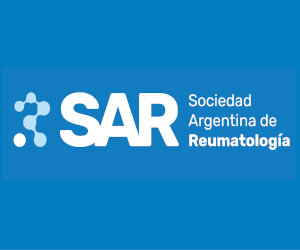Anti-annexin A5 antibody levels and manifestations of obstetric primary antiphospholipid syndrome
Abstract
Antiphospholipid Syndrome (APS) describes an autoimmune thrombophilic disorder characterized by obstetric complications. Annexin A5 (Anx A5) is a protein that is studied as a new autoantigen present in APS, the presence of autoantibodies against Anx A5 could cause placental thrombosis and possibly pregnancy loss. The aim of this study was to analyze levels of IgG and IgM anti-Anx A5 in women with primary obstetric APS and its association with different complications in a population of the city of Córdoba. We worked with samples of puerperal patients who attended the Córdoba Hospital and the Maternal Neonatal Hospital during the years 2013-2017 with a diagnosis of obstetric APS and a control group formed by patients with normal pregnancies. In most of the patients studied, levels of IgG and IgM anti-Anx A5 were below the reference range, is demonstrate an increase statistically significant in the levels of the IgG in patients with APS compared with control group. But there were no specific associations between antibody levels and the three types of obstetric clinical manifestations present in the classification criteria. These findings could suggest a relationship between anti-Anx A5 antibodies and obstetric APS.References
I. D’Ippolito S, Meroni PL, Koike T, Veglia M, Scambia G, Di Simone N. Obstetric antiphospholipid syndrome: A recent classification for an old defined disorder. Autoimmunity Reviews. 2014; (13):901–08.
II. Mallhi SC, Neerja Kushwaha M, Chatterjee BT, Philip CJ. Antiphospholipid syndrome: A diagnostic challenge. Medical Journal Armed Forces India. 2016; (72):31–36.
III. Esteve-Valverdea E, Ferrer-Oliveras R, Alijotas-Reig J. Síndrome antifosfolipídico obstétrico. Revista Clínica Española. 2015; (3):135–45.
IV. Misasi R, Capozzi A, Longo A, Recalchi S, Lococo E, Alessandri C, et al. ‘‘New’’ Antigenic Targets and Methodological Approaches for Refining Laboratory Diagnosis of Antiphospholipid Syndrome. Journal of Immunology Research. 2015; (2015):1-13.
V. Miyakis S, Lockshin M, Lockshin D, Atrumi T, Branch DW, Brey RL, et al. International consensus statement on an update of the classification criteria for definite antiphospholipid syndrome (APS). Journal of Thrombosis and Haemostasis. 2006; (4):295–306.
VI. Yelnik CM, Flint Porter T, Ware Branch D, Laskin CA, Merrill JT, Guerra MM, et al. Changes in Antiphospholipid Antibody Titers During Pregnancy: Effects on Pregnancy Outcomes. ARTHRITIS & RHEUMATOLOGY. 2016. (68); 8:1964–69.
VII. Bertolaccini ML, Sanna G. Recent advances in understanding antiphospholipid syndrome. F1000Research. 2016; (5):1–9.
VIII. Bouter A, Carmeille R, Gounou C, Bouvet F, Degrelle SA, Evain-Brion D, et al. Review: Annexin-A5 and cell membrane repair. Trophoblast Research. 2015; (29):43–49.
IX. Shulan Z, Ziyan W, Jing L, Xiaoting W, Liubing L, et al. Evaluation of the clinical relevance of anti-annexin-A5 antibodies in Chinese patients with antiphospholipid syndrome. Clin Rheumatol. 2017; (36):407–12.
X. Rand JH, Wu XX, Quinn AS, Taatjes DJ. The annexin A5-mediated pathogenic mechanism in the antiphospholipid syndrome: role in pregnancy losses and thrombosis. Lupus. 2010; (19):460–69.
XI. Bećarević Mirjana. The IgG and IgM isotypes of anti-annexin A5 antibodies: relevance for primary antiphospholipid syndrome. J Thromb Thrombolysis. 2016.
XII. Mejía-Mejía MV, Segura Cardona AM, Velásquez Escobar MC, Arango White MC, Abad Restrepo J, Orrego Vélez M, et al. Descripción de la presencia de anticuerpos antianexina V, cardiolipina y B2-glicoproteína I en mujeres con pérdidas gestacionales recurrentes en la ciudad de Medellín, Colombia. Revista colombiana de obstetricia y ginecología. 2012; (63):368-75.
XIII. Matsuda J, Gotoh M, Saitoh N, Gohch K, Tsukamoto M, Yamamoto T. Anti-annexin antibody in the sera of patients with habitual fetal loss or preeclampsia. Trombosis research. 1994; (75) 1:105-106.
XIV. Sater MS, Finan RR, Mustafa FE, Wassim GM, Almawi Y. Anti-annexin V IgM and IgG autoantibodies and the risk of idiopathic recurrent spontaneous miscarriage. J Reprod Immunol. 2011; (89) 1:78–83.
XV. Matsubayashi H, Arai T, Izumi S, Sugi T, McIntyre JA, Akino T. Antiannexin V antibodies in patients with early pregnancy loss of implantation failure. Fertil Steril. 2001; (26):694–9.
XVI. Nojima J, Kuratsune H, Suehisa E, Futsukaichi Y, Yamanishi H, Machii T, et al. Association between the Prevalence of Antibodies to b2-Glycoprotein I, Prothrombin, Protein C, Protein S, and Annexin V in Patients with Systemic Lupus Erythematosus and Thrombotic and Thrombocytopenic Complications. Clinical Chemistry. 2001; (6):1008-15.
XVII. Alijotas-Reig J, Ferrer-Oliveras R, Rodrigo-Anoro MJ, Farran-Codina I, Llurba-Olivé E, Vilardell-Tarres M, et al. Anti-annexin A5 antibodies in women with spontaneous pregnancy loss. Med Clin (Barc). 2010; (10) 134:433–38.
XVIII. Rezk A, Abdel-Hafeez N, Rageh IM, Abdalla W. Anti-annexin as a marker in patients with recurrent miscarriages. Middle East Fertilility Society Journal. 2010; (15)1:47–50.
Copyright (c) 2018 Argentine Journal of Rheumatology

This work is licensed under a Creative Commons Attribution-NonCommercial-NoDerivatives 4.0 International License.










